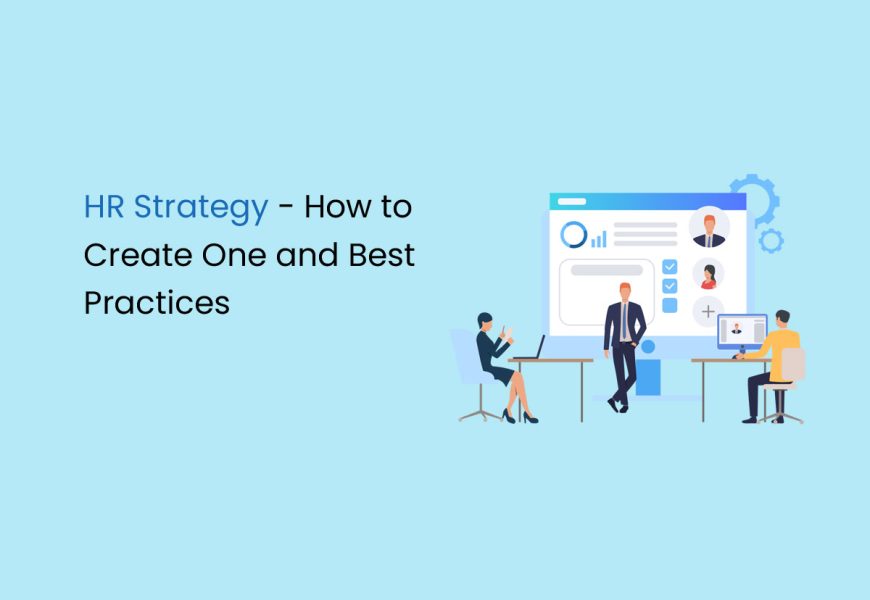Creating an HR strategy for managing your employees is crucial for your company. This plan should help your employees improve their skills and help your company reach its goals. To make a good plan, you need to think about your employees’ skills and what your company will need in the future. This way, your employees will work towards the same goals as your company, which will help your company be more successful.
Let’s discuss HR strategy, why it is essential, and how it is made.
What is an HR Strategy?
An HR strategy is a plan to align an organisation’s HR practices with its overall business goals and objectives. It clearly outlines the role of HR management in supporting the organisation’s success. It identifies the strategies and HR metrics that will be used to achieve those goals.
Having an HR strategy is essential for organisations because it enables them to plan and manage their human resources efficiently in a way that supports their overall business objectives.
An effective HR plan contains information on the human resource policies, programs, and practices that align with the organisation’s goals. This includes recruitment, training, performance management, and employee engagement. In addition, the HR strategy also consists of methods for measuring progress towards these objectives and identifying any challenges or obstacles that may arise.
HR strategies are designed to enhance business success by inspiring employees to deliver high-quality work. According to Patrick M. Wright, successful HR strategies focus on three key elements:
- Having something: The skills, competencies, and abilities employees possess and can offer to the company.
- Feeling something: The level of commitment, engagement, and motivation demonstrated by employees.
- Doing something: How productive employees are and how well they demonstrate their productivity.
Why is having an HR Strategy important?
Creating an HR strategy is crucial for employers and employees as it aligns the HR function with the organisation’s goals and objectives. A successful HR strategy can:
- Improve the relations between employees and supervisors.
- Speed up the implementation of HR policies.
- Create a work environment that nurtures your company’s culture and promotes strong workplace ethics.
- Encourage fair treatment and cooperation among team members, regardless of age, gender or background.
- Reduce the high turnover rate by improving employee loyalty.
Design an HR Strategy to Align with Business Objectives
To develop an effective human resources strategy that supports your organisation’s business goals, you can follow these five steps:
- Understand your organisation’s mission, strategy, and business goals.
- Identify the critical capabilities and skills needed to achieve those goals.
- Evaluate the current capabilities and skills of the talent and HR function and identify any gaps between the current state and future needs of the organisation.
- Develop HR goals to resolve the identified gaps and establish criteria for measuring the successful execution of a strategy.
- Communicate the HR strategy to all relevant stakeholders within the organisation.
How to Create an HR Strategy
You can create an effective human resources strategy by following these steps:
Understand the Business and its Objectives
A successful human resources strategy is closely linked to the organisation’s objectives and mission. Collaborating with management or executives is crucial to determining the company’s short- and long-term growth goals.
Evaluate Employee Skillsets
You should conduct a skills inventory for each employee to determine their areas of expertise. This can help better understand how employees can further contribute to the company’s goals. Doing so lets you identify the company’s strengths and use them to create a more targeted and effective HR strategy.
Perform a SWOT Analysis
Conduct a strengths, weaknesses, opportunities, and threats (SWOT) analysis to identify areas where the company can grow. You can use this analysis to leverage the company’s strengths to capitalise on opportunities in the market. Additionally, by identifying threats and weaknesses, you can put together a plan to overcome them or minimise their impact.
Assess Future HR Needs
You need to assess what employees will require in the future to take advantage of opportunities, mitigate risks, and reach the company’s objectives. You need to figure out the following things:
- Fresh positions that you will have to fill
- The skills that your current employees will need to acquire to fill the new positions
- How to best use the skills of your existing employees
- How HR professionals and their recruitment practices can accommodate the expected expansion.
Evaluate the Need for Additional Tools
Work with your IT department to audit your hardware and software. This helps to identify tools that enable your employees to work more effectively. For example, scheduling, project management, and goal setting can help your team coordinate efforts and improve productivity. There are plenty of productivity tools available to teams, including:
- Recruitment tools: Modern platforms connect human resources managers with new talent seeking a job.
- Employee recognition platforms: These apps are similar to social media and allow employees to be applauded for their achievements within the workforce. They can also provide an easy way for team members to communicate via text.
- Light-speed communication tools: Programs like Slack allow instant messaging and file sharing across platforms, improving productivity and reducing the need for team meetings.
- Online screening tools: You can save time reviewing resumes by screening recruits. This can help you find the most highly trained talent to join and reduce the number of underqualified applicants.
- Time management software: Implementing a digital time clock can make managing time records easier and improve attendance.
Implementing Strategy
Once you have completed the analysis and assessed the company’s needs, it is time to expand the workforce and enhance the skills of existing employees. You can implement an HR strategy by:
- Recruitment of applicants: Look for candidates with the skills you identified during the analysis phase.
- Organise a selection process: Conduct interviews and identify suitable candidates. Choosing relevant questions and tests to assess candidates and their abilities is critical.
- Hiring candidates: Once the required background checks have been completed, extend job offers to the most suitable candidates.
- Designing an onboarding program: An effective employee onboarding program can boost retention rates and help new hires feel confident in their roles more quickly.
Evaluate Your Process
It’s essential to set a timeline to review your progress towards achieving the company’s goals and identify areas for improvement. You should make the necessary adjustments if the current strategies are not working. Implement human resources strategies for at least a year to see results, as it provides sufficient time to track the success of new policies. The following metrics can help quantify your workforce’s performance:
- Employee retention rate
- Overall company growth
- Feedback from managers, employees, and clients
- Financial performance index
- Employee satisfaction surveys
- Goal-based metrics
Benefits of HR Strategy
The benefits of strategic human resources planning are as follows:
- Reduced employee turnover
- Improved employee engagement
- Enhanced productivity
- Attracting superior talent
- Enacting better HR policies
- Minimising business disruptions
Best Practices of HR Strategy
The best practices for implementing an HR strategy:
- Involve key stakeholders: Collaboration is key to a successful strategy. HR professionals should be involved, with sign-off from managers and senior leaders.
- Know the budget: It is essential to ensure that the organisation’s budget financially supports HR strategies.
- Remember the basics: It’s crucial to prioritise administrative responsibilities over strategy. Any violation of compliance can derail even the grandest of plans.
- Recognise transactional solutions: The most efficient solution may not always be the best action. It’s essential to act strategically in every endeavour.
- Monitor and adjust the strategy: Track the effectiveness of your plan over time using key performance indicators (KPIs). If a particular element is not delivering the desired results, revise it accordingly.
Conclusion
Organisations need a clear HR strategy to succeed in the long run that aligns with their overall goals. This allows businesses to bring out the full potential of their workforce, create a culture of innovation and excellence, and handle the complexities of a modern workplace. A strong HR strategy is key to organisational effectiveness. It gives companies a competitive edge in today’s fast-paced business environment.
Frequently Asked Questions
What is HR strategy?
HR strategy is a plan that outlines how to address an organisation's most significant issues by implementing people-focused solutions.
How do you develop an HR plan?
You should conduct a SWOT analysis to develop a strategic HR plan. Once an employer has this information, they can create achievable goals for their strengths and weaknesses.






















